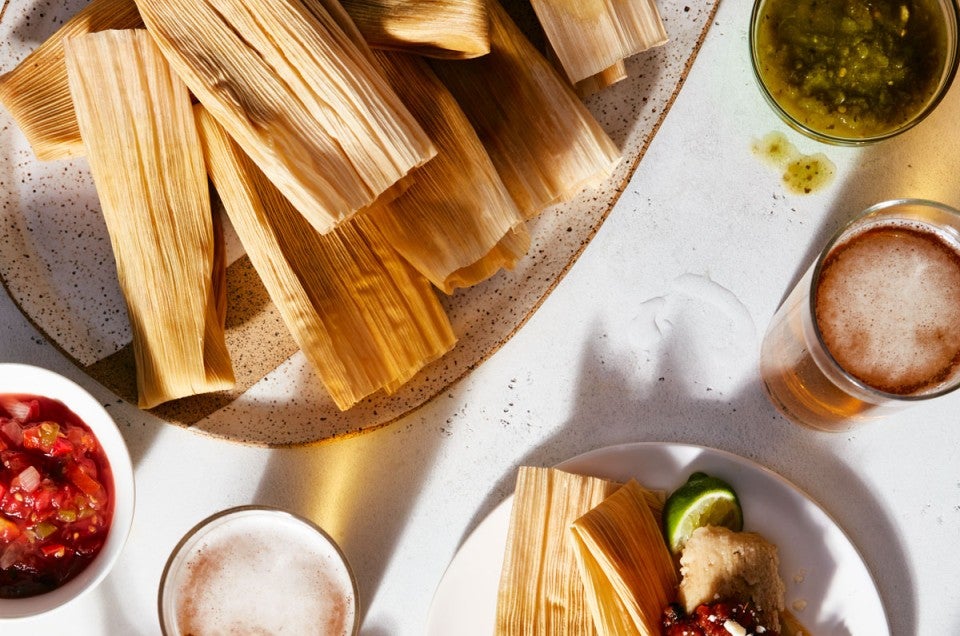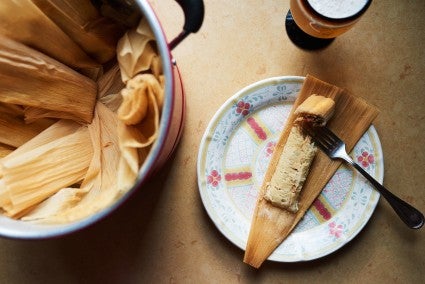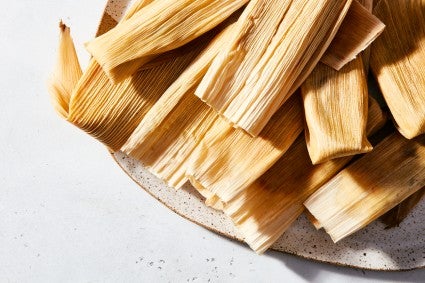Holiday tamal season starts with Thanksgiving leftovers
Traditionally made in December, tamales are making an even earlier holiday appearance.


When Paola Briseño Gonzáles was growing up in Puerto Vallarta, Mexico, tamales were a street food — the kind of thing you’d grab and eat any day of the year. They weren’t exactly front and center during her holiday dinners.
That all changed when she moved to Southern California. “Tamales are [a centerpiece] here,” the chef, writer, and event producer notes of their importance during the holidays in the United States. “[Making tamales over the holidays is] a new tradition that started for me when I moved to L.A.” And it all began with Thanksgiving.
Or, rather, Thanksgiving leftovers. One year, Gonzáles and her husband, L.A. TACO editor Javier Cabral, were gifted holiday leftovers by Cabral’s mother: turkey in a salsa roja. Cabral thought it would make delicious pot pie, but Briseño had another idea: tamales.
It was admittedly a little early for the holiday tamal season. In Mexico, its start is generally marked by the beginning of our winter holidays. The posada tradition starts in mid-December — when tamales are served with a piping hot cup of ponche — and it stretches all the way until February 2, Dia de La Candelaria.
But for some Mexican Americans in the United States the holiday tamal season kicks off even earlier, when they’re served during Thanksgiving. Or even the day after Thanksgiving, when they’re stuffed with the feast’s leftovers. “It's perfect because you can just grab a bunch of leftover stuff, and it’s great for making a lot of tamales,” says Pati Jinich, host of the PBS show Pati’s Mexican Table, chef, and author of three cookbooks.

But even though these ancestral (over 10,000 years old) treats are a perfect vehicle for leftovers, they’re not exactly a quick and easy dinner. Tamales are a labor of love and making them is optimal with a group of people to share the task. For Briseño it started with just Javier, her, and her two sheepdogs in their tamal assembly line; now this tradition of recalentado (reheating of leftovers) has become so treasured that the family shares it with friends.
Briseño makes a couple of salsas, asks friends to bring Thanksgiving leftovers, and they spend their day preparing tamales together. What's best is Briseño doesn’t care if you don’t know how to make them. “I’ll sit them down and tell them, ‘Do this,’ and if they’re like, ‘We don’t know how to make tamales,’ it’s cool. You’re gonna learn today!”
For Andrés M. Garza, chef and co-owner of Neighborhood Molino in McAllen, Texas, tamales have been part of the Thanksgiving celebration ever since they moved to the United States from Mexico. “Tamales were always present,” Garza recounts of the yearly celebrations with their mom’s side of the family. Along with their cousins, they used to watch their grandma preparing them for dinner, waiting until they could dig into the norteño-style tamales and devour them.
The tamales were small, and Garza says they could eat up to six or more as a kid. Whenever they made tamales from leftovers, their family would use turkey meat braised in red salsa, or leftover casserole turned into cheesy tamales de elote. Today, Garza has their sights set on sweet leftover tamales in upcoming celebrations. “I want to make pumpkin pie tamales next,” they say.

The delicate flavor of masa lends itself to a plethora of filling combinations, and Garza says they encourage people to experiment and mix cultures through the masa. “I always over-complicated it or put too much pressure to get them perfect, but making them more and more opens up your world to so much,” Garza marvels.
They advise to season the masa a little extra if you’re making tamales at home: “Be sure your masa is a bit over-seasoned when it’s uncooked or your tamal will be bland. If you’re going savory, make your masa a bit too salty. If you’re going sweet, make it a bit too sweet. When you cook them, the flavors will mellow out.”
Though chef Garza struggles to communicate their feelings about this day, they take this time to engage in meaningful conversations around this settler colonial holiday with their family, friends, and community. “I recognize this day as National Day of Mourning ... In gathering, I hope to re-indigenize this day to the best of my abilities for those around me.” One of the ways they do so is by continuing the tradition of tamales — which was passed down from their grandma, who was deported several years ago and is now absent from this fall celebration — and heirloom maíz. “I continue the tradition now using fresh heirloom masa that I grind myself. I try and share that with my chosen family and my community as best I can.”
As for Briseño, leftover tamales the day after Thanksgiving dinner have become a tradition she’s forged around the family and friends she’s made in the United States. She’ll even overnight ship her delicious maíz creations to a lucky few in her first U.S. home of Portland, Oregon. It’s not a cheap gesture, with overnight fees costing up to $100, but it’s all in the holiday spirit. “I consider it my Christmas present to them,” Briseño says.
Pati Jinich has shared her recipe for Tamales Tapatios (Chicken Tamales from Jalisco), which make an excellent blank canvas for all sorts of leftover-inspired fillings.
Cover photo by Rick Holbrook.

